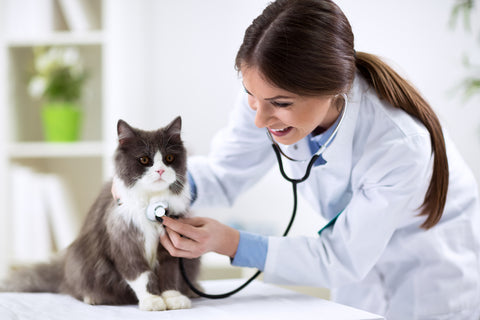
When you receive your cat’s DNA report, you will see a Chromosome Map, which shows your cat’s chromosome pairs with regions of genomic similarity to different breed groups shown in different colors. Many pet parents in the Basepaws community expressed an interest in learning more about what genes reside on each cat chromosome. Here, we share all that is currently known about feline chromosomes and genes associated with hereditary conditions and traits.

DNA and chromosomes
The DNA in cell nuclei is tightly packaged for its storage and protection. This packaging is done with the help of proteins (histones), forming a structure called chromatin. Chromatin is the reason why meters-long DNA can fit inside tiny cells only a few micrometers in diameter. It is a dynamic structure and it is very important for regulating which genes get switched on and off in different cells at different times. A great metaphor for chromatin gene regulation is that genes are like important files stored in a file cabinet. The cabinet’s drawers are always opening and closing and the different files are constantly being pulled out and copied, then returned to their original location.
Inside the cell, chromatin folds into structures called chromosomes. Each chromosome contains a single string of DNA. However, it is important to note that chromosomes should not be thought of as standalone functional units. Genes responsible for similar cellular processes and organismal traits are scattered across different chromosomes. Therefore, it would be inaccurate to say that a particular chromosome is (solely) responsible for eye color, for example.
Cats have 1 pair of sex chromosomes and 18 pairs of autosomal (non-sex) chromosomes (Figure 1). In each chromosome pair, there is one chromosome that comes from the mother and one chromosome that comes from the father. Interestingly, cats and humans share greater chromosomal organization similarity than humans and rodents and cats and rodents. This means that, in a lot of cases, genes found next to each other in human chromosomes are also found next to each other in feline chromosomes.

Figure 1. Graphical representations of each chromosome and trypsin Giemsa-banded staining of the chromosome pairs in domestic cats (Felis catus). Chromosome names follow the convention of Wurster-Hill and Gray (image taken from O’Brien and Nash, 1982).
Feline genes and chromosomes
Although feline genetics is in a much less advanced state than human genetics, years of research have given us some idea of what feline genes are located on each chromosome. Below is a summary of what we know so far.
Chromosome A1
From published literature, we know of 8 genes with well-understood function in disease and trait determination that reside on this chromosome. The gene ARSB is involved in lysosomal storage and mutations in ARSB are associated with lysosomal storage disorders (mucopolysaccharidosis Type VI) in both cats and humans. In cats, this disease and its association with ARSB has been observed in the Siamese and Birman breeds. GM2A and HEXB are another pair of genes located on A1 where mutations have been associated with a lysosomal storage disease (gangliosidosis). Another gene on this chromosome, LIX1, is highly expressed in the brain and it is important for motor neuron survival. A large deletion in LIX1 is implicated in feline spinal muscular atrophy. This deletion has been described in Maine Coons. The gene F12 (or Coagulation factor 12) is associated with blood clotting function and mutations in this gene are characteristic of a disease called Factor XII deficiency in domestic shorthairs. The disease has a relatively high prevalence for a genetic disease, however, it has minimal impact on daily life and functioning. Mutations in another gene found on chromosome A1, the ATP7B gene, have known associations with Wilson disease, which is characterized by excess copper stored in various organs and tissues, particularly the liver. A single nucleotide variation in this gene was reported as a potential cause of Wilson disease in one mixed-breed cat.
When it comes to genes associated with physical traits, LPAR6 and LVRN reside on this chromosome. A small deletion in LPAR6 gives the Cornish Rex breed its curly coat, while various mutations in LVRN are associated with different types of tabby coats.
Chromosome A2
We know of three genes on this chromosome where mutations are associated with particular diseases and physical traits. The first one is CLCN1 which, when mutated, can cause a condition called myotonia congenita - a disease of the skeletal muscles where the muscles cannot relax after a voluntary contraction. The second gene is MAN2B1 which, in some Persian and domestic long-haired breeds, can carry a mutation associated with another lysosomal storage disease - alpha-Mannosidosis. Finally, three different mutations in the ZRS gene located on A2 are seen in polydactyl cats (cats with extra toes).

Polydactyl cat toes
Chromosome A3
Chromosome A3 is home to 4 genes with known associations to disease and one gene associated with coat color. A deletion in the gene GDF7 is linked to a neurological disease called holoprosencephaly was seen in some oriental cats, specifically the breed Toyger. KIF3B is another gene where a disease-relevant mutation has been described. A single nucleotide polymorphism in this gene is associated with progressive retinal atrophy in Bengal cats. The gene SLC3A1 is involved in amino acid transport and mutations in it are seen in feline cystinuria, characterized by defective amino acid reabsorption, leading to cystine urolithiasis. Finally, while hypothyroidism is very rare in cats, a mutation in the gene TPO housed on chromosome A3 appears to be linked to feline congenital hypothyroidism.
The chromosome A3 gene involved in coat color is ASIP, where a 2 basepair deletion is associated with black fur in domestic cats. Other mutations in ASIP are associated with the charcoal coat color in Bengals.
Chromosome B1
We know a lot about the disease and trait-defining genetic variants on chromosome B1. The gene MSFD8 is located here and its mutated version is associated with neuronal ceroid lipofuscinosis. Mutations in the gene IDUA located on B1 are responsible for yet another lysosomal storage disorder - Mucopolysaccharidosis Type I. Additionally, hyperlipoproteinemia (increased lipoprotein concentration in the blood) is conferred by a mutation in the LDL gene.
When it comes to physical traits, chromosome B1 is home to 3 genes with known associations to coat appearance. Different variants of the KIT gene are associated with a completely white coat color or white spotting. Interestingly, genes linked to coat length are also housed on chromosome B1. Multiple mutations in FGF5 are linked to long fur, while mutations in the gene Hairless (HR) are associated with the unique Lykoi fur. A structural variant in the UGDH gene on B1 was also recently described as the culprit for the feline Munchkin breed phenotype (dwarfism).
Chromosome B2
Chromosome B2 houses the gene CMAH which is involved in blood type determination. The gene T is also located on this chromosome. Its different variants confer a variety of different tail lengths. The Manx, American Bobtail and Pixie-Bob breeds all have mutations in T.
Chromosome B3
A mutation in the GLB1 gene located on chromosome B3 is associated with another type of lysosomal storage disease - GM1 Gangliosidosis. In line with the lysosomal storage disease theme, the NPC2 gene linked to Niemann-Pick type C2 disorder can also be found on this chromosome. The potential cause for congenital glaucoma in domestic cats is also on B3, disguised as a mutation in the LTBP2 gene. Yet another gene (CLN6) implicated in Neuronal Ceroid Lipofuscinosis is also located on B3. While MYBPC3 is the most well-known gene associated with hypertrophic cardiomyopathy, a recent study showed that the MYH7 gene (located on B3) is also implicated in the disease. Unlike mutations in MYBC3 which are associated with the disease in Ragdolls and Maine Coons specifically, the MYH7 mutation was characterized in a domestic medium-haired cat of an unidentified breed.
Chromosome B4
Chromosome B4 contains a lot of different genes associated with a variety of genetic diseases. A variant of the gene APOBEC3Z3 is linked to altered susceptibility to the feline immunodeficiency virus, while variants in the CYB5R3 gene are associated with the disease Methemoglobinemia. Alterations in the CYP27B1 gene on B4 are linked to Vitamin D-dependent hereditary rickets. The lysosomal storage disease Mucolipidosis II is potentially caused by a mutation in the GNPTAB gene on this chromosome. There is also some evidence for a hypogonadotropic hypogonadism-related genetic variant of the gene TAC3 found on B3. In this single cat investigation, the feline research subject failed to go through puberty. Lastly, a mutation in the gene CEP290 on B4 is linked to retinal degeneration.
Chromosome B4 also contains two trait-associated genes. Mutations in the KRT71 gene are linked to curly coats in the Devon and Selkirk rex breeds, as well as the Sphynx coat. A variant of the ALX1 gene is also responsible for the craniofacial structure of the Burmese breed.
Chromosome C1
The gene ACVR1 is located on chromosome C1. A mutated version of this gene is associated with the disease Fibrodysplasia ossificans. The gene MLPH is also located on C1. A variant of MLPH is linked to dilute coat color.
Chromosome C2
Chromosome C2 is the home of a gene called COLQ, which, when mutated, is implicated in the disease Congenital Myasthenic syndrome, also known as limb-girdle, seen in Sphynx and Devon rex cats. Another lysosomal storage disease in cats (GM1 Gangliosidosis) is linked to a mutation in the GLB1 gene on C2. ITGB2 is also located on this chromosome and one of its variants is associated with leukocyte adhesion (CD18) deficiency, which is an immunodeficiency condition. Finally, a mutation in the LIPH gene on C2 is associated with the curly coat of the Ural rex breed.
Chromosome D1
MYBPC3 is a very well studied gene in cats. Two mutations in this gene are linked to a hypertrophic cardiomyopathy in Maine Coons and Ragdolls, respectively. A variant of the gene CYP2R1 on chromosome D1 appears to be linked to Type 1b Vitamin D-dependent rickets. Multiple variants of the gene HMBS on D1 have known associations with acute intermittent porphyria. Porphyrias are associated with metabolic errors in the heme biosynthesis pathway. The SMPD1 gene also resides on chromosome D1. A SMPD1 mutation is associated with the lysosomal storage disease Niemann-Pick Type A. A very important gene for coat color is located on D1. Tyrosinase variants are linked to albinism, Siamese and Burmese coat patterns, as well as the mocha coat color.

Chromosome D2
Not much is known about genes associated with diseases and traits on this chromosome. However, we do know that the gene UROS is located on D2. It is involved in heme metabolism and its mutated copies are linked to congenital erythropoietic porphyria.
Chromosome D3
The NPC1 gene associated with lysosomal storage function is located on D3. NPC1 mutations are linked to Niemann‐Pick type C1 disease. The gene TRPV4 also resides on D3. A nucleotide substitution mutation in TRPV4 is associated with the folded ears phenotype in the Scottish Fold breed. All Scottish Folds also have a condition called osteochondrodysplasia, characterized by a malformation in the distal forelimbs, distal hindlimbs and tail, and progressive joint destruction. The disease has different severity in different cats and is a consequence of the same TRPV4 mutation.
Chromosome D4
The COL5A1 gene is housed on this chromosome. A frameshift variant in this gene is associated with Ehler-Danlos syndrome, which is a group of connective tissue disorders caused by defective collagen synthesis or assembly. GRHPR is another gene on D4 where a mutation is associated with disease - primary hyperoxaluria. The gene TYRP1 is also located on D4. Different variants of this gene are associated with chocolate brown and cinnamon coat colors.
Chromosome E1
A mutation in the AIPL1 gene found on this chromosome is associated with Leber Congenital Amaurosis, which is a retinal disease characterized by visual impairment. ITGA2B, the gene associated with Glanzmann thrombasthenia is also located on E1. A mutation in WNK4, another gene located on this chromosome, is responsible for hypokalemic periodic paralysis in Burmese and Burmese-derived breeds. A deletion in the FOXN1 gene is linked to hypotrichosis (sparse hair) with short life expectancy in Birman cats. A mutation in the KRT14 gene found on this chromosome is associated with Epidermolysis bullosa simplex, a blistering disease affecting the skin and mucous membranes. HES7, the gene which when mutated is responsible for the Japanese Bobtail phenotype, is also located on E1.

Chromosome E2
The CRX gene is located on chromosome E2 and it is implicated in eye function. A mutated CRX variant is associated with progressive retinal atrophy (rod-cone dysplasia). Various mutations in the SLC7A9 gene on E2 are associated with type B cystinuria.
An interesting gene linked to coat color is also located on E2 - MCR1. Different mutations in this gene are associated with the colors russet (Burmese cats), copal (Kurilian Bobtail) and amber (Norwegian Forest Cats).
Chromosome E3
The gene PKD1, which when mutated is responsible for polycystic kidney disease, resides on chromosome E3. In addition to PKD1, the gene GUSB involved in the lysosomal storage disease Mucopolysaccharidosis VII is also located on E3.
Chromosome F1
Feline autoimmune hyperproliferative syndrome (seen in British Shorthairs) is associated with a mutation in the gene FASLG located on this chromosome. The PKLR gene is also located on chromosome F1. A mutation in PKLR is linked to erythrocyte pyruvate kinase deficiency, which is a form of inherited hemolytic anemia seen in some Abyssinian and Somali cats, as well as mixed-breed domestic shorthairs.
Chromosome F2
Congenital adrenal hyperplasia is linked to a gene found on this chromosome - CYP11B1. Dihydropyrimidinase deficiency, a rare metabolic syndrome, also has its potential cause on this chromosome in the form of a DPYS mutation.
Chromosome X
It is known from human studies and from the famous familial history of Queen Victoria of England that hemophilia is an X-linked disorder (women are usually carriers, while men are typically the ones affected by the disease). The same has been demonstrated in cats. Hemophilia B is associated with a mutation in the F9 gene found on the X chromosome in cats. A gene associated with inflammatory linear verrucous epidermal nevus (a type of skin outgrowth), NSDHL, is also located on chromosome X. Lastly, it is suspected that the orange coat color is linked to a gene located on the X chromosome, although it is not currently known which gene.
Chromosome Y
Almost nothing is known about the feline Y chromosome. The chromosome is not even a part of the latest feline reference genome.
There is more to it than this…
This is a thorough summary of what we currently know about the genetics of feline diseases and traits in cats. However, this is just a snapshot of the complexity behind feline genetics. Unfortunately, genetic studies in cats are significantly fewer than those in dogs and humans. Basepaws’ mission is to change all of this and put cats in the research spotlight (where they belong). Apart from looking for new genetic culprits for feline diseases, we are working on improving the state of the feline reference genome, which will be instrumental for future discoveries.
Learn more about your cat's genetics with a Basepaws DNA Test. Buy yours meow!
Buy Now


